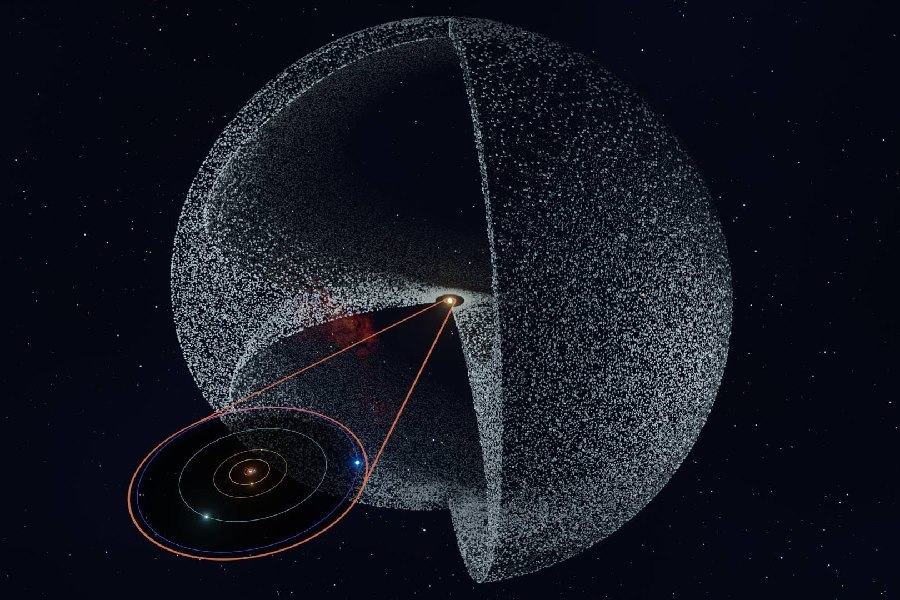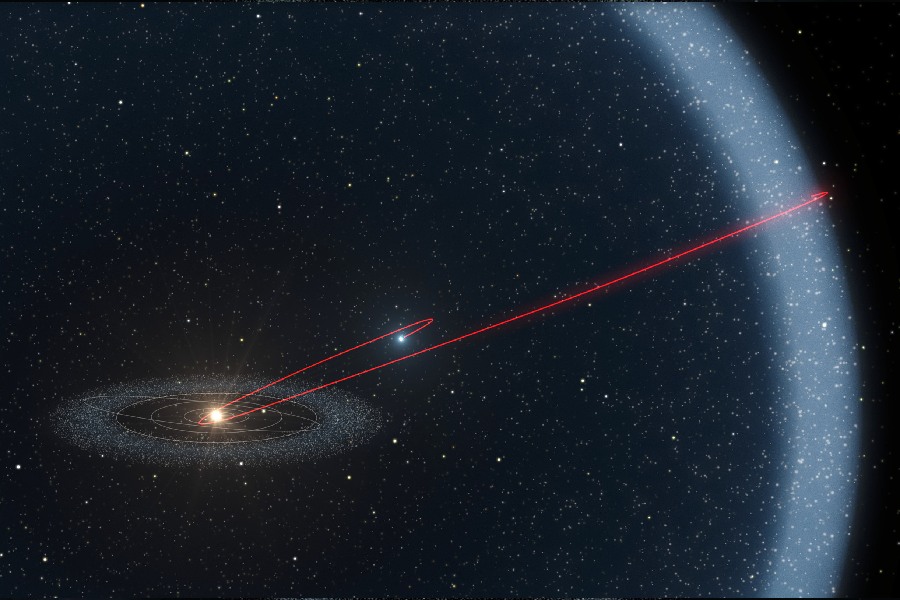The Oort cloud is a vast spherical region surrounding our Solar System. It is often regarded as the outermost boundary of our celestial neighborhood. However, the mysteries of the cosmos extend far beyond this icy realm.
In this article, we embark on a thrilling ride to explore the great unknown that lies beyond the Oort cloud. What is beyond the Oort cloud?
We will dive into the realm of the interstellar medium, a vast expanse of gas and dust that permeates the space between stars. Here, we will unravel the intricate processes that shape the birth and evolution of stars, as well as the formation of new planetary systems.
Prepare to have your curiosity piqued as we explore cutting-edge theories and observations. These hint at the existence of other galaxies, cosmic structures, and even parallel universes that may lie beyond the confines of our observable cosmos.
Join us as we push the boundaries of our knowledge and embark on a journey that will challenge our perceptions of the universe we inhabit.

What Is Beyond the Oort Cloud?
What is beyond the Oort cloud? Beyond the Oort cloud lies the vast expanse of interstellar space. This region extends for trillions of kilometers. It contains rogue comets, asteroids, and potentially undiscovered celestial objects.
It marks the boundary of the Sun’s gravitational influence. This boundary transitions into the realm dominated by other stars and the Milky Way galaxy itself.
While speculative, there may exist a hypothetical outer boundary to the Oort cloud. It’s known as “heliopause”, where the influence of the Sun’s solar wind diminishes entirely. This gives way to the interstellar medium.
Venturing Beyond the Oort Cloud
The Oort cloud, a vast, spherical shell of icy objects, marks the outermost region of our Solar System. These objects, believed to be remnants from the formation of the Solar System, extend from about 2,000 to 100,000 astronomical units (AU) from the Sun, where one AU is the distance between the Earth and the Sun.
The Oort cloud holds significant importance in understanding the origins of our Solar System and is the source of long-period comets that visit the inner Solar System.
Studying the Oort cloud can provide valuable insights into the early stages of planetary formation. However, direct exploration of this distant realm remains a challenge due to its immense distance, and no spacecraft has yet ventured into the Oort cloud.
Interstellar space – Vast distances and challenges
So, what’s past the Oort cloud? Beyond the Oort cloud lies the unfathomable vastness of interstellar space, where distances are measured in light-years, with one light-year being the distance light travels in a single year.
To put the scale into perspective, the nearest star to our Solar System, Proxima Centauri, is about 4.24 light-years away, which is over 265,000 times the distance from the Earth to the Sun.
Propulsion challenges and emerging technologies
Exploring interstellar space presents immense challenges, as conventional propulsion systems would take thousands of years to reach even the nearest stars. However, scientists are developing new technologies, such as light sails and nuclear propulsion, to overcome these challenges.
Interstellar exploration opens up the possibility of discovering new worlds, studying the nature of the universe, and potentially finding signs of extraterrestrial life, making it a frontier that humanity has only begun to contemplate.
The interstellar medium – The space between stars
Interstellar space is not entirely empty; it is filled with a tenuous mixture of gas and dust called the interstellar medium. This medium plays a crucial role in the formation of new stars and planets and is the medium through which light from distant stars travels to reach us.
Studying the composition and properties of the interstellar medium helps astronomers understand the cycle of stellar birth and death in the universe.

Physical Boundaries of the Oort Cloud and Regions Beyond It
Galactic tides – Gravitational forces in interstellar space
Galactic tides are gravitational forces exerted by the collective mass of the Milky Way galaxy, influencing the motion and trajectories of celestial objects beyond the Oort cloud. These tides can cause perturbations in the orbits of comets, asteroids, and other bodies in interstellar space, significantly changing their paths over long periods.
Future interstellar missions must consider the effects of galactic tides to ensure success. Galactic tides play a role in shaping the Oort cloud by disturbing the orbits of icy objects.
This sends those objects toward the inner Solar System as long-period comets. These forces also influence captured interstellar objects and ejected planetesimals and rogue planets.
Astronomical objects beyond the Oort cloud
Long-period comets originate from the Oort cloud, with orbital periods exceeding 200 years. On the other hand, short-period comets come from the Kuiper belt and have periods of less than 200 years.
Halley’s Comet and Comet Encke are notable short-period comets. Interstellar objects, such as ‘Oumuamua and Borisov, originate from outside our Solar System and provide valuable insights into other star systems.
Long-period comets are pristine remnants of the early Solar System, while short-period comets are smaller and less active due to repeated solar heating. The discovery of more interstellar objects through advanced telescopes and techniques will further our understanding of planetary systems beyond our own.
Long-period comets – Ancient wanderers of the cosmos
Long-period comets, ancient wanderers of the cosmos, are believed to originate from the distant Oort cloud and are composed of ice, dust, and rocky material. These comets have elongated and highly eccentric orbits, spending most of their existence in the frigid depths of space.
Gravitational perturbations can nudge them out of their distant orbits, sending them on a journey across interstellar space and toward the inner Solar System.
As they approach the Sun, their icy surfaces sublimate, creating stunning cometary comas and tails. Notable long-period comets include Hale-Bopp, Hyakutake, and Lovejoy, each with their own unique characteristics and orbital periods.
Short-period comets – Swift navigators of distant realms
Short-period comets, swift navigators of distant realms, originate from the Kuiper belt, scattered disc, and Centaur population. These icy bodies are composed of frozen volatiles, rocky material, and dust and have orbital periods typically less than 200 years.
They follow elliptical orbits influenced by the gravitational perturbations of giant planets, particularly Jupiter and Saturn.
Short-period comets visit the inner Solar System more frequently than long-period comets, losing a portion of their volatile material with each perihelion passage. Although most pose no immediate threat, their orbits can evolve over time, potentially raising impact risks.
Notable short-period comets include Halley’s Comet, with a 75-76 year orbital period, Comet Encke, with the shortest known orbital period of 3.3 years, and Comet 67P/Churyumov-Gerasimenko, the target of the Rosetta mission.
Conclusion
As we come to the end of our exploration into the vast unknown beyond the Oort cloud, we hope you have realized the immense mysteries and wonders that await us in the cosmos.
This article has helped you understand better that our universe extends far beyond the boundaries we once thought existed. It reveals a tapestry of enigmatic phenomena and unexplored realms.
While we have unraveled some theories and observations that hint at the answers to what is beyond the Oort cloud, our journey of discovery has just begun. The cosmos continues to captivate and humble us with its vastness and complexity.
It invites us to push the boundaries of our knowledge and embark on new adventures of scientific exploration. The universe’s secrets await those with an insatiable curiosity and a relentless pursuit of understanding.
